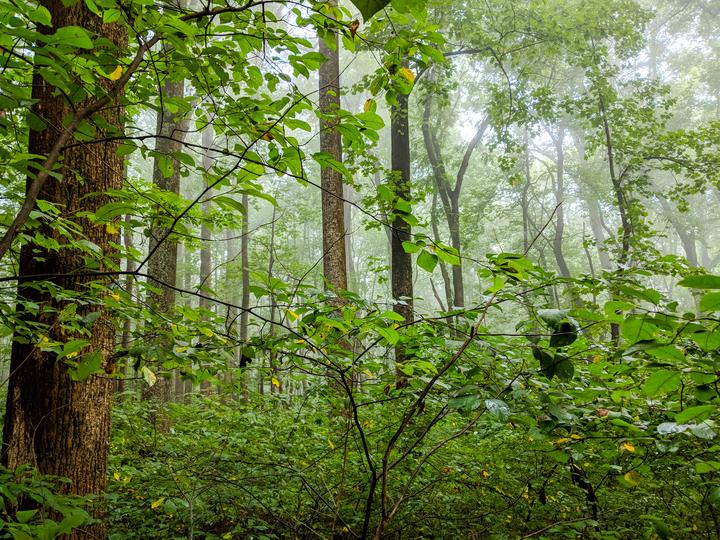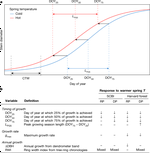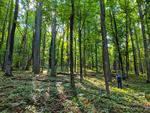SCBI ForestGEO
Last updated on
2021-04-15
 A foggy day in the ForestGEO plot
A foggy day in the ForestGEO plotThis project represents work stemming from my time interning in-person with the Smithsonian Conservation Biology Institute from 2018-2019 and continued work thereafter. On campus, I was part of the surveying team for the five-year census of the Forest Global Earth Observatory (ForestGEO) plot, which is a 26.5 ha tract representative of the Blue Ridge forest ecoregion. After the census, I contributed to other research in the plot including coordinating dendroband surveys, collecting data for a multi-plot study, and analyzed plant responses to drought over time (McGregor et al 2020).
Publications
In an era of rapid environmental change, accurate data on ecological dynamics are essential to understanding the resistance and …
Albert Y. Kim, Valentine Herrmann, Ross Bareto, Brianna Calkins, Erika B. Gonzalez-Akre, Daniel J. Johnson, Jennifer Jordan, Lukas Magee, Ian R. McGregor, Nicolle Montero, Karl Novak, Teagan Rogers, Jessica Shue, Kristina J. Anderson-Teixeira
As the climate changes, warmer spring temperatures are causing earlier leaf-out and commencement of net carbon dioxide (CO2) …
Cameron Dow, Albert Y. Kim, Loïc D’Orangeville, Erika B. Gonzalez-Akre, Ryan Helcoski, Valentine Herrmann, Grant L. Harley, Justin T. Maxwell, Ian R. McGregor, William J. McShea, Sean McMahon, Neil Pederson, Alan J. Tepley, Kristina J. Anderson-Teixeira
Rising temperatures are profoundly influencing forests on many scales with potentially strong variation vertically across forest …
Nidhi Vinod, Martijn Slot, Ian R. McGregor, Elsa M. Ordway, Marielle N. Smith, Tyeen Taylor, Lawren Sack, Kristina J. Anderson-Teixeira
Plant diversity varies immensely over large-scale gradients in temperature, precipitation, and seasonality at global and regional scales. One hypothesis predicts that the many defensive compounds found in plants’ metabolomes should increase in richness and decrease in interspecific similarity with precipitation, temperature, and plant diversity. To test this prediction, we compared patterns of chemical and morphological trait diversity of 140 woody plant species among seven temperate forests in North America representing 16.2 °C variation in mean annual temperature (MAT), 2,115 mm variation in mean annual precipitation (MAP), and from 10 to 68 co-occurring species. Our results are consistent with the hypothesis that plant metabolomes play a more important role in community assembly in wetter and warmer climates, even at temperate latitudes, and suggest that metabolomic traits can provide unique insight to studies of trait-based community assembly.
Brian E. Sedio, Marko J. Spasojevic, Jonathan Myers, Stuart J. Wright, Maria D. Person, Hamssika Chandrasekaran, Jack H. Dwenger, María L. Prechi, Christian A. López, David N. Allen, Kristina J. Anderson-Teixeira, Jennifer L. Baltzer, Norman A. Bourg, Buck T. Castillo, Nicola Day, Emily Dewald-Wang, Christopher W. Dick, Timothy Y. James, Jordan Kueneman, Joseph Lamanna, James A. Lutz, Ian R. McGregor, Sean M. McMahon, Geoffrey G. Parker, John D. Parker, John Vandermeer
Tree-ring records from a long-term forest monitoring plot in NW Virginia (USA) reveal that tree height and leaf drought tolerance traits influenced growth responses during and after significant droughts in the meteorological record. As climate change-induced droughts intensify, tall trees with drought-sensitive leaves will be most vulnerable to immediate and longer-term growth reductions.
Ian R. McGregor, Ryan Helcoski, Norbert Kunert, Alan J. Tepley, Erika B. Gonzalez-Akre, Valentine Herrmann, Joseph Zailaa, Atticus E. L. Stovall, Norman A. Bourg, William J. McShea, Neil Pederson, Kristina J. Anderson-Teixeira
Public data repository of the SCBI ForestGEO plot, with recent updates including hydraulic traits data, the 2020 annual tree mortality …
Erika Gonzalez-Akre, Ian R. McGregor, Kristina J. Anderson-Teixeira, Cameron Dow, Valentine Herrmann, Alyssa Terrell, Albert Y. Kim, Nidhi Vinod, Ryan Helcoski
Climate data for ForestGEO sites around the world
Kristina J. Anderson-Teixeira, Bianca Gonzalez, Ian R. McGregor, Erika Gonzalez-Akre, Ryan Helcoski, Valentine Herrmann, Albert Y. Kim, Alyssa Terrell, Cameron Dow
From 3 decades (1987–2019) of forest monitoring data in the Blue Ridge Mountains ecoregion, we found exotic forest insects and pathogens (EFIP) substantially affected at least eight tree genera. Several taxa were lost from our monitoring plots but not completely extirpated from the region. Despite these losses, both total AGB and alpha-diversity were largely recovered through increases in sympatric genera. These results indicate that EFIP have been an important force shaping forest composition, carbon cycling, and diversity.
Kristina J. Anderson-Teixeira, Valentine Herrmann, Wendy B. Cass, Alan B. Williams, Stephen J. Paull, Erika B. Gonzalez-Akre, Ryan Helcoski, Alan J. Tepley, Norm A. Bourg, Christopher T. Cosma, Abigail E. Ferson, Caroline Kittle, Victoria Meakem, Ian R. McGregor, Maya N. Prestipino, Michael K. Scott, Alyssa R. Terrell, Alfonso Alonso, Francisco Dallmeier, William J. McShea
When droughts occur, large dominant trees, drought sensitive species, and individuals in moist microhabitats are likely to be most strongly affected. These findings highlight the urgent necessity of integrating multiple data streams across time scales to resolve the climate sensitivity of forest productivity.
Kristina J. Anderson-Teixeira, Ryan Helcoski, Ian R. McGregor, Alan J. Tepley, Valentine Herrmann, Erika B. Gonzalez-Akre, Norbert Kunert, Neil Pedersen, Lawren Sack, Atticus E. Stovall
Events
Contributed poster for the VWL annual meeting
2019-03-24
Smithsonian Conservation Biology Institute



